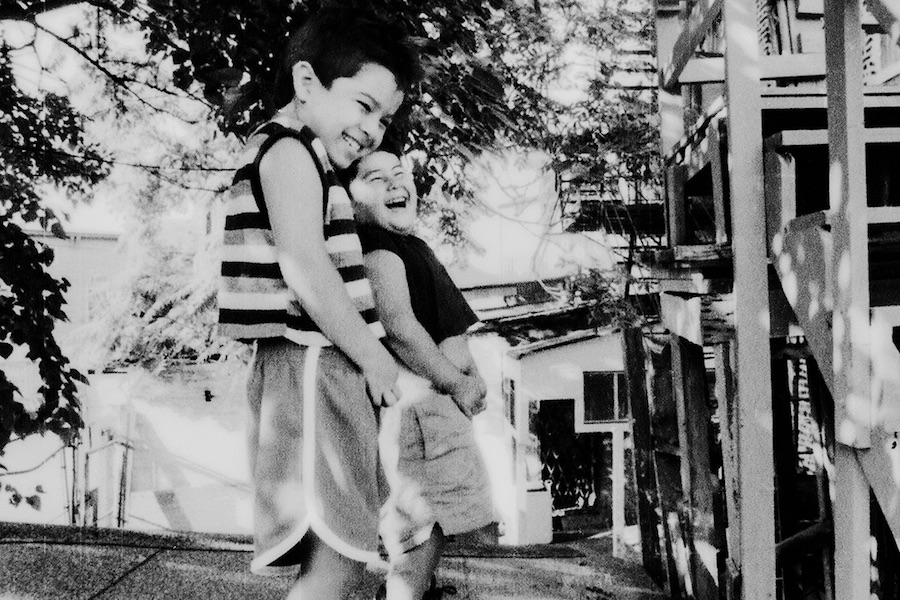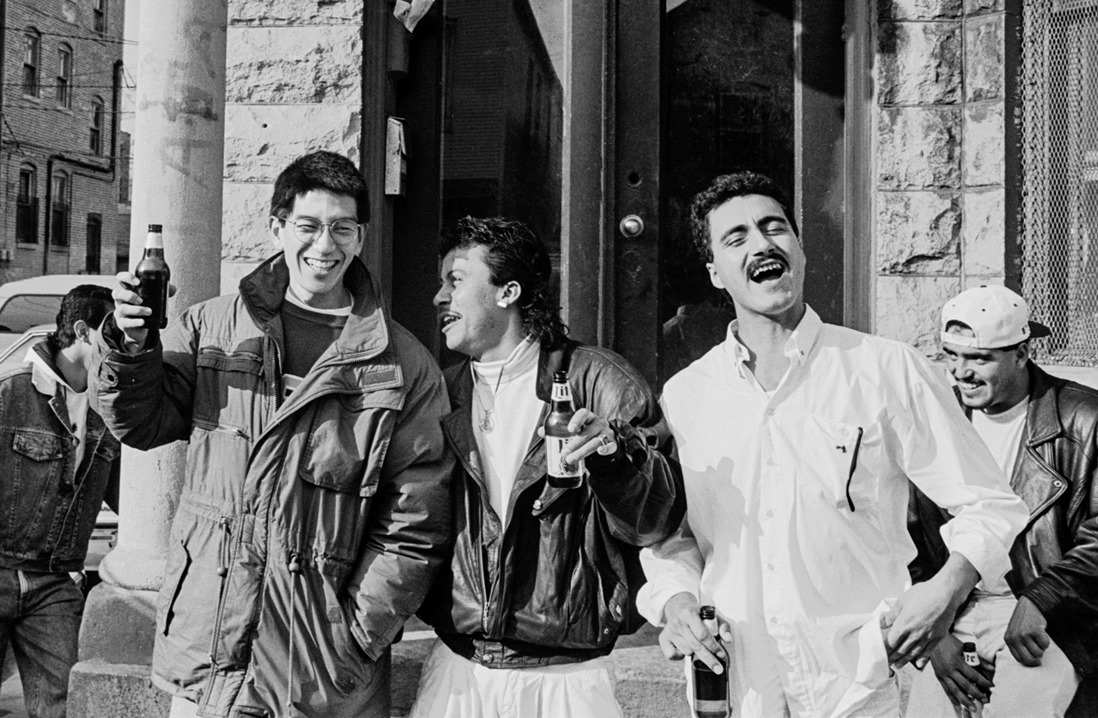Akito Tsuda’s photographs of Pilsen live on the coffee tables, bookshelves, and Facebook feeds of current and former residents. When he uploads an image to Facebook, the comments are filled with precise memories of the moments he captured. People tag friends and family; sometimes, they offer tributes to those who’ve passed, their smiling faces frozen in time.
Originally from Japan, Tsuda spent three years photographing the neighborhood as a Columbia College student in the 1990s. He spoke some English and no Spanish, but spent his free time exploring Pilsen, a tight-knit yet welcoming neighborhood he happened upon purely by chance — one migrant watching how other immigrants live in a new place. He returned to Japan in 1994, taking his photos with him, where they were kept in storage for more than 20 years.
The black and white photographs show Pilsen in the early to mid-1990s, before the neighborhood began showing signs of gentrification. So far, Tsuda has published two books of his collection, made me better than before (2015) and Pilsen Days (2017).
Moira Pujols, who co-manages the community space Cultura in Pilsen, says many with roots in the neighborhood treat his books like family photo albums.
“Those days when he was here taking the pictures, it was a low-income neighborhood,” Gina Duran-Negrete, a former resident, says. “A lot of families couldn’t afford cameras and stuff, let alone go to a photographer and take professional pictures.”

Tsuda first began uploading the photos to Facebook in 2016, tagging them with #pilsen or #pilsenneighborhood, he says. He had been out of contact with people from Pilsen since 1994, but awareness snowballed on social media as former and current Pilsen residents found the time capsule they didn’t know existed. The next year, Cultura in Pilsen and other local community groups fundraised to bring Tsuda back to Pilsen for the first time in decades, spurred by the reporting of freelance journalist Jacqueline Serrato.
“The people of Pilsen helped me realize the value of these photos,” Tsuda says. “If it weren’t for them, they might still be in my storage.”
Tsuda captured some 400 photos of the community at its most intimate and unrehearsed: children clamor together, smiling for the camera. Women and girls apply makeup in the mirror, celebrity posters wallpapering their bedroom. In one, an older man is caught in action collecting recyclables from dumpsters, an aluminum can suspended mid-air as he tosses it in his shopping cart.
When Duran-Negrete first began seeing Tsuda’s pictures pop up on her Facebook feed, she knew he had to have seen her grandfather in the neighborhood. She messaged the photographer privately, describing her grandfather and asking if he ever encountered the man who collected cans. Tsuda said he remembered him but asked for some time to comb through his sizable collection.
Isaac Santos was a sweet, religious man well-known by neighbors, who often saw him trailed by a pack of stray dogs that waited in the gangway by his home for him each day. Duran-Negrete’s family lived in Pilsen for decades until the mid- to late ’90s, when they moved due to gang activity. In 2016, she was driving her car when Tsuda messaged her back with the news that he had found a photo of someone he thought might be Santos.

“I literally had to park, and I cried my eyes out because it was so emotional,” Duran-Negrete says. “These pictures are a gift Pilsen residents never knew we had.”
At Cafe Jumping Bean on 18th Street, Tsuda says the warm reception by Pilsen residents has been enough to make his work worthwhile. But as he’s heard more about how gentrification has priced out longtime residents — and as racist anti-immigrant sentiment roils nationwide — he hopes to find a more permanent, public venue to share his work. Last month, he returned to Chicago to visit with residents and scope out possibilities for permanent installation, meeting with potential locations and interested parties. He is currently searching for libraries, museums, or universities that could house his collection, but he has not yet found the right location.
When asked if he has an ideal place in mind, Tsuda is slightly reticent, but describes how, as a student, he looked forward to reading the Japanese newspapers and magazines kept in rotation at Harold Washington Library.
“I want to place these photos somewhere where many people will have access to them,” Tsuda says. “I hope my work might be able to provide an opportunity for others to understand why people are saddened by how the community is changing — a visual representation of how much Pilsen loves their city.”

(1).jpg)
During his most recent visit, Tsuda was reunited with longtime Pilsen residents, some traveling from out-of-state to see him. At one event, attendees attached printed copies of Tsuda’s photos onto a large map of Pilsen, retracing the photographer’s steps and the community’s memories. But even that project is not enduring in the way Tsuda hopes his work will be preserved.
Pujols also believes strongly in the need for the collection to be housed somewhere permanent, a way to keep a record of Pilsen and its larger part in Chicago history.
“[By placing the photos somewhere public], hopefully Chicagoans can find themselves in these photos — not just gaze at them as Mexicans in Chicago, but to actually give the feeling that this is part of Chicago,” she says.
But for those in the photos — and those reunited with long-lost family and friends through Tsuda’s work — the pictures bear witness not just to history, but to the life they lived and the neighborhood that raised them.
Gabriela Marchan was just a little girl when Tsuda was photographing Pilsen. Around the time Tsuda began uploading the photos, she came across a picture of an older woman, not immediately recognizing the woman as her great-grandmother. She sent it to her aunt, who happened to be with her grandmother at the time.
“[My grandmother] got very emotional. She hasn't had a picture of her mom in who knows how long,” Marchan says, flipping through a copy of Pilsen Days.
.jpg)
In one photo, she and her siblings smile for the camera. Marchan and her brother Ricardo point themselves and family members out to her young daughter sitting beside her, who squints her eyes to make out the young faces. Occasionally her inspections are punctuated by surprised exclamations — Wait, that’s you?! — and the relaying of stories, names, and places by Marchan.
“It’s bittersweet because you want to see your neighborhood progress,” Ricardo says. “But at the same time, they’re pushing out some very great people who were here before.”
Editor’s note: Tsuda’s quotes have been translated from Japanese by the author.




